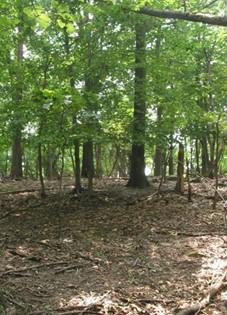Deer are herbivores and their diet primarily consists of browse (leaves, twigs, and buds of woody plants), forbs (herbaceous broad-leaved plants, including agricultural crops), hard and soft mast (acorns, nuts, fruits), grass and mushrooms/lichens. An average adult white-tailed deer requires 5-7 pounds of food daily per 100 pounds of body weight, which equates to over 1 ton of vegetation consumed by one deer in one year.
At high population densities deer can greatly alter landscapes through intensive browsing on vegetation which can have lasting negative impacts on forest dynamics and biodiversity. Through selective foraging, deer affect forest plant communities by reducing tree seedling numbers resulting in changes to forest age structure and composition over time. In many areas within Fairfax County, there is little to no regeneration of trees due to consumption of seedlings and saplings by deer. Forest structure has become impaired and simplified with removal of understory and shrub layers by deer. Additionally, seed banks (seeds stored in forest soils for future generation) will not be replenished and will decline over time. White-tailed deer not only alter vegetation structure through direct browse damage to native plants (lowering their ability to become established), but also impact forest health through the dispersal of non-native, invasive plants.
Deer significantly influence wildlife habitat by altering the forest’s composition and structure which can lead to a loss of biodiversity and fewer species supported in the ecosystem. Healthy forests include deer but also many other species of insects, plants and other wildlife that evolved to be a part of our local biodiversity. The ecological changes created by overabundant deer have cascading effects on other species. Damage caused by overbrowsing can result in loss or displacement of other wildlife species that depend on these habitats for food, cover, and nest/den sites, including insects, birds, and other mammals. Over time, deer herd health also declines as habitat is degraded and more deer must compete for depleted natural foods and other resources.

